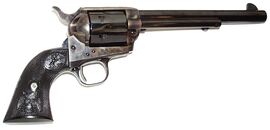
The Colt Single Action Army, one of the most popular revolvers of all time
A revolver is a multishot firearm, usually a handgun, in which the rounds are held in a revolving cylinder that rotates to fire them through a single barrel.
Overview[]
Revolver-type weapons are part of the long development of making better multi-shot weapons. They were partly an attempt to improve on pepper-box type weapons, which used a revolving cylinder with one set of firing mechanisms, but which had multiple barrels as well. Firing through a single barrel saved the expense and weight of having the multiple barrels of the Pepper-box. While many revolving chamber designs were tried, the first widely successful revolvers were based on mechanisms patented by Samuel Colt. It is believed that Samuel Colt came up with the idea for the revolver while at sea, inspired by the ship's wheel. Revolvers have remained popular to the present day in many areas, although they have largely been supplanted by magazine-fed semi-automatic pistols such as the Colt 1911, especially in circumstances where reload time and higher cartridge capacity is deemed important.
A revolver works by having several firing chambers arranged in a circle in a cylindrical block that is brought into alignment with the firing mechanism and barrel one at a time. A single-action revolver requires the hammer to be pulled back by hand before each shot. In contrast, in a double-action revolver, squeezing the trigger can pull back the hammer to cock the gun as well as serving to release the hammer. Most modern double-action revolvers can also be fired in the single-action mode as well, which serves to improve the shooting accuracy by reducing the force required to pull the trigger. Because of the effort required to cock the hammer is part of the firing action in a double-action revolver, they can generally be fired faster than a single action, but at the cost of reduced accuracy in the hands of most shooters.
Most commonly, such guns have a five- or six-shot capacity (hence the other name Six Shooter); however, some revolvers have up to a 10-shot capacity (this often depends on the caliber, though different companies produce revolvers in the same calibers with different capacities, due to other design differences), and each chamber has to be reloaded manually. This makes the procedure of reloading such a weapon slow (even with the help of such devices as speedloaders). The alternatives are a replaceable cylinder, a speedloader which can reload all chambers at once, or a moon clip that holds a full load (Or even half of one in the case of a half-moon clip) of ammunition and that is inserted along with the ammunition.
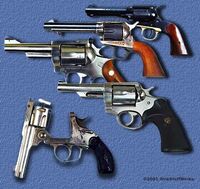
Photo of different types of modern revolvers.
Due to the simplicity of design, a revolver is easier to make and has higher reliability than other multi-shot firearms in extreme environments. For these reasons, such guns are the most commonly-owned weapons for personal self-defense and hunting applications, where their capability to fire powerful ammunition with great accuracy has maintained their popularity. For example, should a semiautomatic pistol fail to fire, clearing the chamber requires manually cycling the action to remove the errant round, as cycling the action normally depends on the energy of a cartridge firing. With a revolver, this is not necessary as none of the energy for cycling the revolver comes from the firing of the cartridge, but is supplied by the user either through cocking the hammer or, in a double-action design, by just squeezing the trigger.
Over the long period of development of the revolver, many calibers have been used. Some of these have proved more durable during periods of standardization and some have entered general public awareness. Among these are the .22 rimfire, a popular target shooting caliber; .38 Special and .357 Magnum, known for police use; the .44 Magnum, famous from Clint Eastwood's Dirty Harry films; and the .45 Long Colt, used in the Colt revolver of the "Wild West". Introduced in 2003, the Smith & Wesson Model 500 is the most powerful production revolver ever created, using the .500 S&W round.
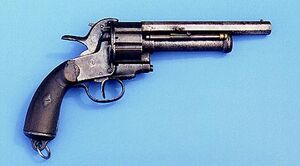
The LeMat Revolver, an unusual 9-shot revolver from the Civil War era with 8 revolving chambers firing bullets and a center barrel firing shot.
Revolvers have generally fallen out of favor with police and militaries because of their relatively low ammunition capacities and long reload times. Famous military revolvers include the Webley, the Colt Single Action Army and the Smith & Wesson 1917. Many police forces still use revolvers for backup weapons (usually .357 Magnum or .38 Special).
Revolver technology does live on in other weapons used by the military. Some autocannons and grenade launchers use mechanisms similar to revolvers, and some riot shotguns use spring-loaded cylinders holding up to 12 rounds.
Loading and unloading[]
The first revolvers were front-loading, which meant that each chamber in the cylinder was loaded from the front with loose powder and a bullet: chambers were thus not fully bored through the cylinder. Usually, there was a loading lever attached to the bottom of the barrel that gave the user leverage to force the oversized lead ball into the chamber, which sealed it and held the ball and powder securely in place. The first practical revolvers were caplocks, because the caplock method of priming allowed all chambers to be primed at once rather than having a flash pan that needed refilling after each shot (which greatly decreased the potential rate-of-fire advantage of multiple chambers), and was significantly less prone to an extremely dangerous phenomenon called "row ignition" where the spark from the flint or flash pan sets off multiple chambers at once. Since the bullet did not have to be rammed down the entire length of the barrel, revolvers could easily incorporate rifled barrels, a technology that was centuries old but had been mostly impractical in muzzle-loaded weapons due to the force required to shove the projectile down the rifling.
The first generation of cartridge revolvers (discounting those using the not particularly successful pinfire cartridge design) was converted caplock designs. In many of these (especially those that were converted long after manufacture), the pin on which the cylinder revolved was removed, and the cylinder taken from the gun for loading. Later models used a loading gate at the rear of the cylinder that allowed one cartridge at a time to be accessed for loading, while a rod under the barrel could be pressed backwards to extract the fired case. Most revolvers using this method of loading are single action revolvers. Since the cylinder is firmly attached at the front and rear of the frame, and since the frame is full thickness all the way around, most large caliber hunting revolvers tend to be single action. The loading gate on the original Colt designs (copied by nearly all single-action revolvers since) is on the right side, which slightly favors left-handed users, who are in the minority among pistol users. Samuel Colt himself was left-handed, explaining this design choice.
The next method used for loading and unloading cartridge revolvers was the top break design. It was first used when Smith & Wesson made the Schofield revolver. In a top break revolver, the frame is hinged at the bottom front of the cylinder. Releasing the lock and pushing the barrel down brings the cylinder up - this exposes the rear of the cylinder for reloading. In most top break revolvers, the act of pivoting the barrel and cylinder operates an extractor that pushes the cartridges in the chambers back far enough that they will fall free, or can be removed easily. Fresh rounds are then placed into the cylinder, either one at a time or all at once with either a speedloader or a moon clip. The barrel and cylinder are then rotated back and locked in place, and the revolver is ready to fire. Since the frame is in two parts, held together by a latch on the top rear of the cylinder, top break revolvers are relatively weak, and cannot handle high pressure rounds. Top break designs are nearly extinct in the world of firearms, but they are still found in air guns.
The last and now most common method of loading and unloading is the swing out cylinder. The cylinder is mounted on a pivot referred to as a crane that is coaxial with the chambers, and the cylinder swings out and down (to the left in most cases, due to right-handed shooters being in the majority). An extractor is fitted, operated by a rod projecting from the front of the cylinder assembly. When pressed, it will push all the casings free simultaneously (as in top break models, the travel is designed to not completely extract longer, unfired rounds). The cylinder may then be loaded, singly or again with a speedloader, and closed, where it latches in place. The crane is the weak point of swing-out cylinder designs. Using the method often portrayed in movies and television of flipping the cylinder open and closed with a flick of the wrist will in fact cause the crane to bend, throwing the cylinder out of alignment with the barrel. Lack of alignment between chamber and barrel is a dangerous condition- impeding the bullet's transition from chamber to barrel. This gives rise to higher pressures in the chamber, bullet damage, and the potential for an explosion if the bullet becomes stuck. The shock of firing can also put a great deal of stress on the crane, as in most designs the cylinder is only held closed at one point, the rear of the cylinder. Stronger designs, such as the Ruger Super Redhawk, use a lock in the crane as well as the lock at the rear of the cylinder. This latch provides a more secure bond between cylinder and frame, and allows the use of larger, more powerful cartridges.
Single action[]
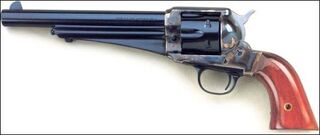
Remington single action 1875
In a single action revolver, the hammer is manually cocked, usually with the thumb of the firing or supporting hand. This action advances the cylinder to the next round and locks the cylinder in place with the chamber aligned with the barrel. The trigger, when pulled, releases the hammer, which fires the round in the chamber. To fire again, the hammer must be manually cocked again. This is called "single action" because the trigger only performs a single action, of releasing the hammer. Because only a single action is performed and trigger pull is lightened, firing a revolver in this way allows most shooters to achieve greater accuracy.
Single-action pistols with simple triggers can be fired rapidly by holding the trigger down while working the hammer with the other hand, a procedure referred to as "fan firing" or "fanning." It is a common misconception that this was a popular tactic in Wild West gunfights: in actuality, it was only popular in trick-shooting shows, and came to be associated with the image of cowboys popularized in Wild West shows around the turn of the 20th century.
Double action[]
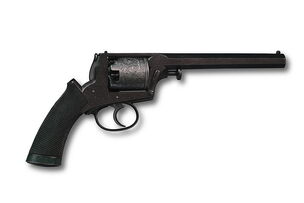
1851 Adams Revolver, an early double action revolver
Most double action revolvers may be fired in two ways. The first way is exactly the same as a single action revolver; the hammer is cocked, which advances the cylinder, and when the trigger is pulled, this releases the hammer. Double action revolvers also can be fired from a hammer down position, by just pulling the trigger. In this case, the trigger first cocks the hammer (thus advancing the cylinder) and then releases the hammer at the rear of its travel, firing the round in the chamber. Certain revolvers, called double action only, lack the latch that enables the hammer to be locked to the rear, and thus can only be fired in the double action mode. With no way to lock the hammer back, double action only designs tend to have bobbed or spurless hammers, and may even have the hammer completely covered by the revolver's frame or be striker-fired. These are generally intended for concealed carry for defensive purposes, where a hammer spur could snag when the revolver is drawn. The potential reduction in accuracy in aimed fire is offset by the increased usability for concealed carry. Double action revolvers have appeared as early as the 1850s as Remington and Britain began producing cap and ball double action revolvers.
There is a broad misconception that double-action revolvers in some way qualify as semi-automatic, but this is not the case: no part of the energy of firing automates the process of operation in a double-action revolver. They are manually operated, with the operating lever happening to also be the trigger.
Use with silencers[]
As a general rule, revolvers cannot be equipped with a silencer, as there is usually a gap that exists between the revolving cylinder and the barrel over which a bullet must traverse or jump when fired. As this opening is not gas-tight, a portion of the propellant gas will escape from the cylinder gap and produce a flash and sound no matter how effective a suppressor is fitted to the barrel.
The only way to address this is to use a gas-seal design: the Nagant M1895 is the most well-known example of such a revolver, and can indeed accept a silencer. Other silenced revolvers, mostly custom made, have been manufactured: these often feature a large integral suppressor designed to cover the cylinder gap, with some kind of gate or other structure to allow loading.
Unusual revolvers[]
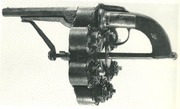
A transitional revolver with a 48-shot Enouy device attached.
A number of revolvers very different from the regular image of this type of weapon have existed over the centuries. One such oddity was Joseph Enouy's patent, which pertained to a device that would be fixed to the underside of a transitional-type percussion revolver. The device consisted of eight revolver cylinders attached by spokes to a rotating wheel, itself fixed to a central axis that ran from the grip of the revolver to the end of the barrel. After a cylinder was depleted, unscrewing the axis could allow the user to disengage the frame of the revolver and manually turn the wheel to rotate a new cylinder into the revolver's frame. Only one such revolver was ever made, and it was unwieldy and heavy. Enouy also developed more practical two-cylinder revolvers that operated on a similar principle.
A similar fate awaited multi-barrel revolvers: these weapons, often pinfire, used complicated hammer designs and multi-layered cylinders to fire shots from two or even three barrels at the same time.
Due to Colt's patent, a number of very strange alternative designs for revolving weapons were created in his era: these include the chain revolver (in which a belt of chambers are used with a gas-seal mechanism) and the turret revolver, which used an extremely dangerous disc-shaped radial "cylinder" where chambers faced outwards from the point of rotation, including one pointing directly backwards: a potentially lethal feature in a weapon that proved more prone to row ignition than a standard revolver.
Automatic revolvers[]
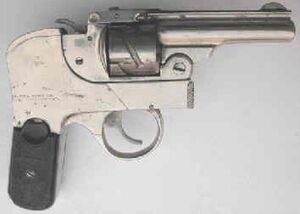
Union Automatic Revolver.
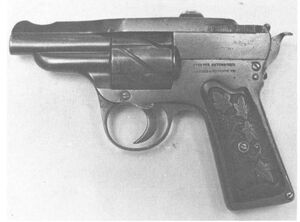
Zulaica Automatic Revolver.
There is a rare class of revolvers, the automatic revolver, that attempts to give the high speed of a double action with the trigger effort of a single action. It should be noted that "automatic" revolvers are usually semi-automatic, and that the term was historically more commonly used to refer to break-open revolvers with "automatic" cartridge extractors.
Since weapons of this type require some part of the weapon to move, they typically have a slide of some sort. They have never been particularly successful: rather than combining the simplicity and reliability of a revolver with the fire rate of a semi-auto as designers probably hoped, they instead combine the complexity of a semi-auto with the magazine capacity of a revolver.
The Webley Fosbery Automatic Revolver was the first commercial example, introduced in 1901. It was recoil-operated, and the cylinder and barrel recoiled backwards to cock the hammer and revolve the cylinder. It was distinctive in that cam grooves were milled on the outside of the cylinder to provide a means of advancing to the next chamber—half a turn as the cylinder moved back, and half a turn as it moved forward. .38 caliber versions held 8 shots, .455 caliber versions 6. The automatic revolver was popular when it first came out, but was quickly supplanted by reliable, inexpensive semi-automatic pistols which were already starting to enter production at the time (for example, the first Luger pistol models and the Mauser C96). Another known example was the Spanish Zulaica automatic revolver.
In 1997, the Mateba company developed a type of recoil-operated automatic revolver, commercially named the Mateba Autorevolver, which uses the recoil energy to auto-rotate a normal revolver cylinder holding 6 or 7 cartridges, depending on the model. The company has made several versions of its Autorevolver, including longer barelled and carbine variations, chambered for .357 Magnum, .44 Magnum and .454 Casull.
The Pancor Jackhammer was a prototype combat shotgun based on a similar mechanism to the Webley-Fosberry. It uses a gas action to move the barrel forward (which unlocks it from the cylinder) and then rotate the cylinder and cock the hammer.
Invention and early patents[]
Snaphaunce revolvers with single fixed barrel, automatic cylinder rotation, and positive cylinder alignment—were made in the late 17th century. The earliest known specimen, now in the Tower of London armories, is dated about 1680 and attributed to John Dafte of London. But wheel-lock revolvers with manual rotating cylinder where already available in the 16th century. One of the oldest models was designed by Hans Stopler in 1597.

A replica of a revolving flintlock.
Captain Artemas Wheeler, an American military officer, patented a flintlock revolver in June 1818. Wheeler's colleagues Elisha Haydon Collier and Cornelius Coolidge made improvements to the design and patented it in Britain and France in November of the same year. Wheeler's original patent was lost in 1836. Collier moved to London to arrange for production of this gun by Evans & Co. Several hundred Collier revolvers were produced, most of which were sold to the East India Company.
The revolving flintlock features multiple barrels (or cylinders) which held bullets and powder, and would revolve upon firing, making it easier to fire more bullets in battle.
Samuel Colt received a British patent for his revolver (more specifically, for the concept of a revolver action in which the hammer is linked to a mechanism that advances the cylinder) in 1835 and an American patent (number 138) on February 25, 1836 for a Revolving gun, and made the first production model on March 5 of that year.
Another revolver patent was issued to Samuel Colt on August 29, 1839. The February 25, 1836 patent was then reissued as US patent RE124 entitled Revolving gun to Samuel Colt on October 24, 1848. This was followed by US patent 7613 on September 3, 1850 for a Revolver, and by US patent 7629 on September 10, 1850 for a Revolver.
Famous Brands and Manufacturers[]
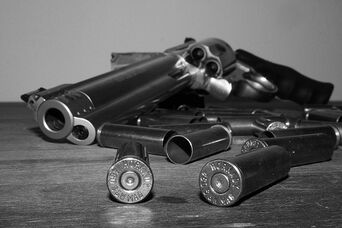
A revolver
- Adams
- Tranter
- Remington
- Enfield
- Nagant
- Ghoda
- Colt
- Magnum Research
- Ruger
- Smith & Wesson
- Taurus
- Webley & Scott
- Armscor
- Charter Arms
- North American Arms
- Astra
- Freedom Arms
- Harrington and Richardson
- Iver Johnson